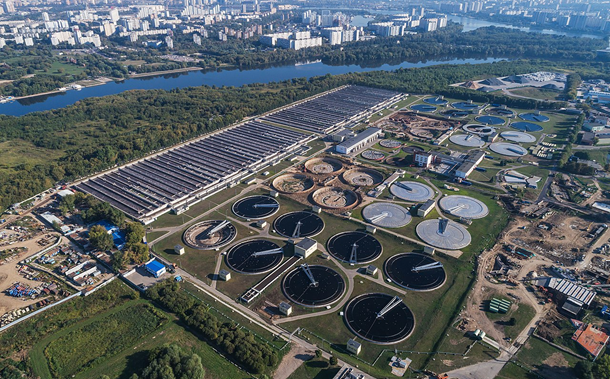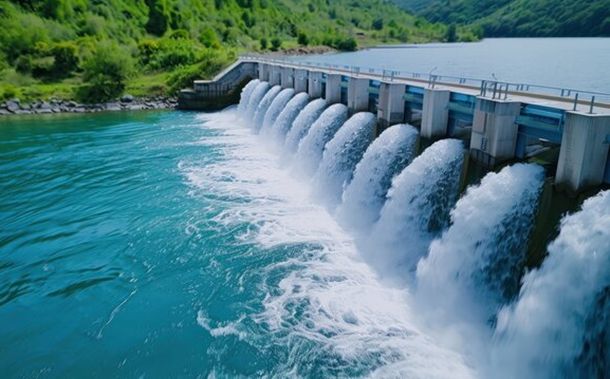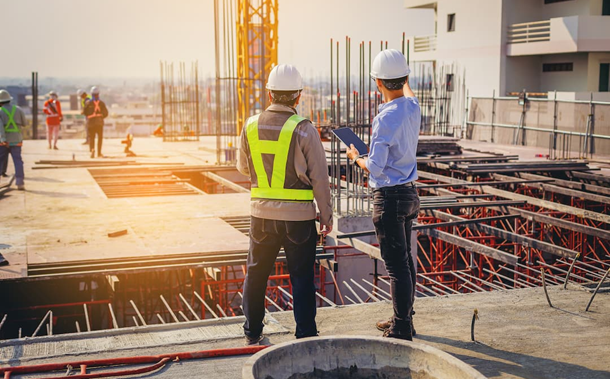Subsurface Mapping and Geotechnical Design for Landslide Mitigation
Downloads
The landslide near the PT Molindo Incinerator Unit poses a significant threat to the facility’s structural integrity. Without immediate mitigation measures, the incinerator building is at risk of collapse, potentially impacting adjacent settlements due to cascading structural failures. To reduce the risk of further instability, urgent geophysical investigation is required to characterize the subsurface lithology and assess the groundwater table conditions. A geoelectrical resistivity survey was conducted using the Schlumberger configuration across 8 measurement points along a 100-meter survey line, with 10-meter electrode spacing. The resistivity measurements ranged from 3.30 to 25 Ωm, which were interpreted as clay-rich layers; 26 to 167 Ωm, corresponding to sandy clay; and 167 to 15,944 Ωm, indicating bedrock. The potential slip zone is interpreted at an average depth of 20 to 25 meters, indicated by very low resistivity values with resistivity values between 3.30 and 25 Ωm. Field observations confirmed that the landslide materials predominantly consisted of clay soils, distributed within two distinct layers beneath the incinerator unit. The combined depth of the clay and overlying sandy layers was estimated to reach approximately 20-25 meters from the ground surface. To ensure the effectiveness of structural mitigation, a retaining wall must be designed to extend beyond this depth threshold. Numerical simulations using Slope/W software indicated that soil nailing techniques yielded safety factors ranging from 1.32 to 1.81 under static conditions and 1.22 to 1.43 under dynamic conditions. Predicted deformations ranged from 0.01 to 0.02 meters (static) and 0.02 to 0.03 meters (dynamic). These results suggest that soil nailing is a viable reinforcement method to stabilize slope movements, particularly during periods of high rainfall. Additional recommended mitigation strategies include the installation of surface and subsurface drainage systems to control water flow, constructing retaining structures to serve as physical barriers to soil movement, and using vegetative cover to enhance slope stability.
Downloads
[1] Shanmugam, G., & Wang, Y. (2015). The landslide problem. Journal of Palaeogeography, 4(2), 109–166. doi:10.3724/SP.J.1261.2015.00071.
[2] Boyd, J. P., Binley, A., Wilkinson, P., Holmes, J., Bruce, E., & Chambers, J. (2024). Practical considerations for using petrophysics and geoelectrical methods on clay rich landslides. Engineering Geology, 334, 107506. doi:10.1016/j.enggeo.2024.107506.
[3] Ghiasi, V., Pauzi, N. I. M., Karimi, S., & Yousefi, M. (2023). Landslide risk zoning using support vector machine algorithm. Geomechanics and Engineering, 34(3), 267–284. doi:10.12989/gae.2023.34.3.267.
[4] Susilo, A., Juwono, A. M., Aprilia, F., Hisyam, F., Rohmah, S., & Hasan, M. F. R. (2023). Subsurface Analysis Using Microtremor and Resistivity to Determine Soil Vulnerability and Discovery of New Local Fault. Civil Engineering Journal (Iran), 9(9), 2286–2299. doi:10.28991/CEJ-2023-09-09-014.
[5] BPBD Malang Regency. (2022). Data Kejadian Bencana Kabupaten Malang (Data on Disaster Events in Malang Regency). Regional Disaster Management Agency (BPBD), Malang Regency Government, Jakarta, Indonesia.
[6] Hasan, M. F. R., Susilo, A., Suryo, E. A., Agung, P. A. M., Wiyono, Pratiwie, D. L., & Dewi, N. M. (2024). Assessment and simulation of potential landslide caused by the rainfall intensity in Batu City during 2021. IOP Conference Series: Earth and Environmental Science, 1314(1), 12017. doi:10.1088/1755-1315/1314/1/012017.
[7] Ering, P., & Babu, G. L. S. (2016). Probabilistic back analysis of rainfall induced landslide- A case study of Malin landslide, India. Engineering Geology, 208, 154–164. doi:10.1016/j.enggeo.2016.05.002.
[8] Mickus, K., Frifita, N., Ben Zaied, M., & Ouessar, M. (2022). Gravity and electrical resistivity analysis of deep and shallow structures related to aquifers within the Jeffara Plain, southeast Tunisia. Journal of African Earth Sciences, 196, 104685. doi:10.1016/j.jafrearsci.2022.104685.
[9] Pun, W. K., Chung, P. W. K., Wong, T. K. C., Lam, H. W. K., & Wong, L. A. (2020). Landslide Risk Management in Hong Kong - Experience in the Past and Planning for the Future. Landslides, 17(1), 243–247. doi:10.1007/s10346-019-01291-8.
[10] Luat, N. V., Do, T. N., Nguyen, L. C., & Kien, N. T. (2024). Assessing landslide susceptibility along the Halong – Vandon expressway in Quang Ninh province, Vietnam: A comprehensive approach integrating GIS and various methods. Geomechanics and Engineering, 37(2), 135–147. doi:10.12989/gae.2024.37.2.135.
[11] Yunita, F. T., Soekarno, I., Nugroho, J., & Santosa, U. B. (2024). Empirical Model of Unconsolidated Tephra Erosion: Verification and Application on Micro Catchment. Civil Engineering Journal, 10(7), 2088-2104. doi:10.28991/CEJ-2024-010-07-02.
[12] Whiteley, J. S., Watlet, A., Uhlemann, S., Wilkinson, P., Boyd, J. P., Jordan, C., Kendall, J. M., & Chambers, J. E. (2021). Rapid characterisation of landslide heterogeneity using unsupervised classification of electrical resistivity and seismic refraction surveys. Engineering Geology, 290, 106189. doi:10.1016/j.enggeo.2021.106189.
[13] Hasan, M. F. R., Salimah, A., Susilo, A., Rahmat, A., Nurtanto, M., & Martina, N. (2022). Identification of Landslide Area Using Geoelectrical Resistivity Method as Disaster Mitigation Strategy. International Journal on Advanced Science, Engineering and Information Technology, 12(4), 1484–1490. doi:10.18517/ijaseit.12.4.14694.
[14] Chaiyaput, S., Suksawat, T., Mase, L. Z., Sugiyama, M., & Ayawanna, J. (2023). The thickness of the soft soil layer and canal-side road failure: A case study in Phra Nakhon Si Ayutthaya province, Thailand. Geomechanics and Engineering, 35(5), 511–523. doi:10.12989/gae.2023.35.5.511.
[15] Di Maio, R., Salone, R., De Paola, C., Carbonari, R., Cusano, D., & De Vita, P. (2024). Geotechnical and geophysical property models of soil-covered slopes prone to landsliding. The case study of the Ischia Island (southern Italy). Catena, 247, 108509. doi:10.1016/j.catena.2024.108509.
[16] Hasan, M. F. R., Susilo, A., Suryo, E. A., Agung, P. A. M., Pratama, A., Idmi, M. H., & Mustaffa, A. A. (2024). The use of geoelectrical resistivity methods to detect the potential landslides in Payung, Batu City, Indonesia. IOP Conference Series: Earth and Environmental Science, 1347(1), 12003. doi:10.1088/1755-1315/1347/1/012003.
[17] Sujitapan, C., Kendall, J. M., Chambers, J. E., & Yordkayhun, S. (2024). Landslide assessment through integrated geoelectrical and seismic methods: A case study in Thungsong site, southern Thailand. Heliyon, 10(2), 24660. doi:10.1016/j.heliyon.2024.e24660.
[18] Hasan, M. F. R., Adi, S., & Sunaryo. (2018). Identification of underground river flow pattern using self-potential (SP) and resistivity methods for drought mitigation at Druju, Sumbermanjing Wetan, Indonesia. Disaster Advances, 11(5), 25–31.
[19] Hasan, M. F. R., Pradiptiya, A., Setiawan, Y., Agung, P. A. M., Susilo, A., & Sunaryo. (2022). Detection of groundwater sources in Lembor village using geoelectrical resistivity method schlumberger configuration. IOP Conference Series: Earth and Environmental Science, 1116(1), 12051. doi:10.1088/1755-1315/1116/1/012051.
[20] Sunaryo, Susilo, A., Yuwono, A. M., & Wiyono, W. (2019). Slope Stability Analysis for Landslides Natural Disaster Mitigation by Means of Geoelectrical Resistivity Data in Gedangan of South Malang, East Java, Indonesia. IOP Conference Series: Materials Science and Engineering, 546(2), 22030. doi:10.1088/1757-899X/546/2/022030.
[21] Arya, I. W., Wiraga, I. W., & Suryanegara, I. G. A. G. (2018). Effect of cement injection on sandy soil slope stability, case study: Slope in Petang district, Badung regency. Journal of Physics: Conference Series, 953(1), 12103. doi:10.1088/1742-6596/953/1/012103.
[22] Santosa, S., & Atmawinata, S. (1992). Geological Map of The Kediri Quadrangle, Jawa. Geological Research and Development Centre, Bandung, Indonesia.
[23] Liu, Y., Xiao, H., Yao, K., Hu, J., & Wei, H. (2018). Rock-soil slope stability analysis by two-phase random media and finite elements. Geoscience Frontiers, 9(6), 1649–1655. doi:10.1016/j.gsf.2017.10.007.
[24] Çellek, S. (2020). Effect of the Slope Angle and Its Classification on Landslide. Copernicus GmbH (Preprint), 1-23. doi:10.5194/nhess-2020-87.
[25] Marino, P., Comegna, L., Damiano, E., Olivares, L., & Greco, R. (2020). Monitoring the hydrological balance of a landslide-prone slope covered by pyroclastic deposits over limestone fractured bedrock. Water (Switzerland), 12(12), 3309. doi:10.3390/w12123309.
[26] Ling, C., Xu, Q., Zhang, Q., Ran, J., & Lv, H. (2016). Application of electrical resistivity tomography for investigating the internal structure of a translational landslide and characterizing its groundwater circulation (Kualiangzi landslide, Southwest China). Journal of Applied Geophysics, 131, 154–162. doi:10.1016/j.jappgeo.2016.06.003.
[27] Bachri, S., Shrestha, R. P., Yulianto, F., Sumarmi, S., Utomo, K. S. B., & Aldianto, Y. E. (2021). Mapping landform and landslide susceptibility using remote sensing, GIS and field observation in the Southern Cross road, Malang regency, East Java, Indonesia. Geosciences (Switzerland), 11(1), 1–15. doi:10.3390/geosciences11010004.
[28] Azarafza, M., Nanehkaran, Y. A., Rajabion, L., Akgün, H., Rahnamarad, J., Derakhshani, R., & Raoof, A. (2020). Application of the modified Q-slope classification system for sedimentary rock slope stability assessment in Iran. Engineering Geology, 264, 105349. doi:10.1016/j.enggeo.2019.105349.
[29] Castro, J., Asta, M. P., Galve, J. P., & Azañón, J. M. (2020). Formation of clay-rich layers at the slip surface of slope instabilities: The role of groundwater. Water (Switzerland), 12(9), 2639. doi:10.3390/w12092639.
[30] Telford, W. M., Geldart, L. P., & Sheriff, R. E. (1990). Applied Geophysics. Cambridge University Press, Cambridge, United Kingdom. doi:10.1017/cbo9781139167932.
[31] Imani, P., Tian, G., Hadiloo, S., & El-Raouf, A. A. (2021). Application of combined electrical resistivity tomography (ERT) and seismic refraction tomography (SRT) methods to investigate Xiaoshan District landslide site: Hangzhou, China. Journal of Applied Geophysics, 184, 104236. doi:10.1016/j.jappgeo.2020.104236.
[32] Uhlemann, S., Chambers, J., Wilkinson, P., Maurer, H., Merritt, A., Meldrum, P., Kuras, O., Gunn, D., Smith, A., & Dijkstra, T. (2017). Four-dimensional imaging of moisture dynamics during landslide reactivation. Journal of Geophysical Research: Earth Surface, 122(1), 398–418. doi:10.1002/2016JF003983.
[33] Wicki, A., Lehmann, P., Hauck, C., & Stähli, M. (2023). Impact of topography on in situ soil wetness measurements for regional landslide early warning - a case study from the Swiss Alpine Foreland. Natural Hazards and Earth System Sciences, 23(3), 1059–1077. doi:10.5194/nhess-23-1059-2023.
[34] Hasan, M. F. R., Agung, P. A. M., Susilo, A., Suryo, E. A., Zainorabidin, A. Bin, & Hermawan, A. R. (2024). Wedge Slope Failure of Natural Sedimentary Rock Formation Based on Weathering Potential. International Journal of Design and Nature and Ecodynamics, 19(2), 387–396. doi:10.18280/ijdne.190204.
[35] Rout, S. K., De, M., Mandal, A. K., & Das, B. (2019). Soil Nailing for Failed Slope Stabilization on Hilly Terrain. Geotechnics for Transportation Infrastructure. Lecture Notes in Civil Engineering , 28, Springer, Singapore. doi:10.1007/978-981-13-6701-4_40.
[36] Pandey, A., Jaiswal, S., & Chauhan, V. B. (2021). Numerical Studies on the Behavior of Slope Reinforced with Soil NailsLocal Site Effects and Ground Failures. Lecture Notes in Civil Engineering, Springer, Singapore. doi:10.1007/978-981-15-9984-2_19.
[37] Dewedree, S., & Jusoh, S. N. (2019). Slope stability analysis under different soil nailing parameters using the SLOPE/W software. Journal of Physics: Conference Series, 1174(1), 12008. doi:10.1088/1742-6596/1174/1/012008.
[38] Villalobos, S. A., & Villalobos, F. A. (2021). Effect of nail spacing on the global stability of soil nailed walls using limit equilibrium and finite element methods. Transportation Geotechnics, 26, 100454. doi:10.1016/j.trgeo.2020.100454.
[39] Mohamed, M. H., Ahmed, M., & Mallick, J. (2021). Pullout behavior of nail reinforcement in nailed soil slope. Applied Sciences (Switzerland), 11(14), 6419. doi:10.3390/app11146419.
[40] Teshale, E., & Legesse, A. (2022). The Effects of Vetiver Grass (Vetiver Zizanodes L.) on Soil Fertility Enhancement, Soil Water Conservation, Carbon Sequestration and Essential oil Productions A: Review. Journal of Natural Sciences Research, 8(1), 25–31. doi:10.7176/jnsr/13-5-04.
[41] Ma, S., Xu, C., Xu, X., He, X., Qian, H., Jiao, Q., Gao, W., Yang, H., Cui, Y., Zhang, P., Li, K., Mo, H., Liu, J., & Liu, X. (2020). Characteristics and causes of the landslide on July 23, 2019 in Shuicheng, Guizhou Province, China. Landslides, 17(6), 1441–1452. doi:10.1007/s10346-020-01374-x.
[42] Mahmoudpour, M., Gholami, S., Ehteshami, M., & Salari, M. (2021). Evaluation of Phytoremediation Potential of Vetiver Grass (Chrysopogon zizanioides (L.) Roberty) for Wastewater Treatment. Advances in Materials Science and Engineering, 3059983. doi:10.1155/2021/3059983.
[43] Liu, X., Lan, H., Li, L., & Cui, P. (2022). An ecological indicator system for shallow landslide analysis. Catena, 214, 106211. doi:10.1016/j.catena.2022.106211.
[44] Nghia, N. T., Lam, L. G., & Hino, T. (2019). Combining soil nail and vetiver grass in a slope protection project in Vietnam. Lowland Technology International, 21(1), 14–22.
[45] Lavania, S. (2019). Vetiver grass model and phenomics of root system architecture. The Journal of Indian Botanical Society, 98(3and4), 176. doi:10.5958/2455-7218.2019.00020.2.
[46] Nguyen, B. T., Ishikawa, T., & Murakami, T. (2020). Effects evaluation of grass age on hydraulic properties of coarse-grained soil. Transportation Geotechnics, 25, 100401. doi:10.1016/j.trgeo.2020.100401.
[47] Sittadewi, E. H., & Tejakusuma, I. G. (2019). the Role of Root Plant Architecture in Landslide and Erosion Disaster Mitigation. Jurnal Sains Dan Teknologi Mitigasi Bencana, 14(1), 54–61. doi:10.29122/jstmb.v14i1.3552.
[48] Tsige, D., Senadheera, S., & Talema, A. (2019). Stability Analysis of Plant-Root-Reinforced Shallow Slopes along Mountainous Road Corridors Based on Numerical Modeling. Geosciences, 10(1), 19. doi:10.3390/geosciences10010019.
[49] Zhang, L., Li, M., & Zhao, B. (2018). Experimental Study on Tensile Properties and Reinforcement Ability of Plant Roots. Nature Environment & Pollution Technology, 17(3), 729-738.
- Authors retain all copyrights. It is noticeable that authors will not be forced to sign any copyright transfer agreements.
- This work (including HTML and PDF Files) is licensed under a Creative Commons Attribution 4.0 International License.![]()














